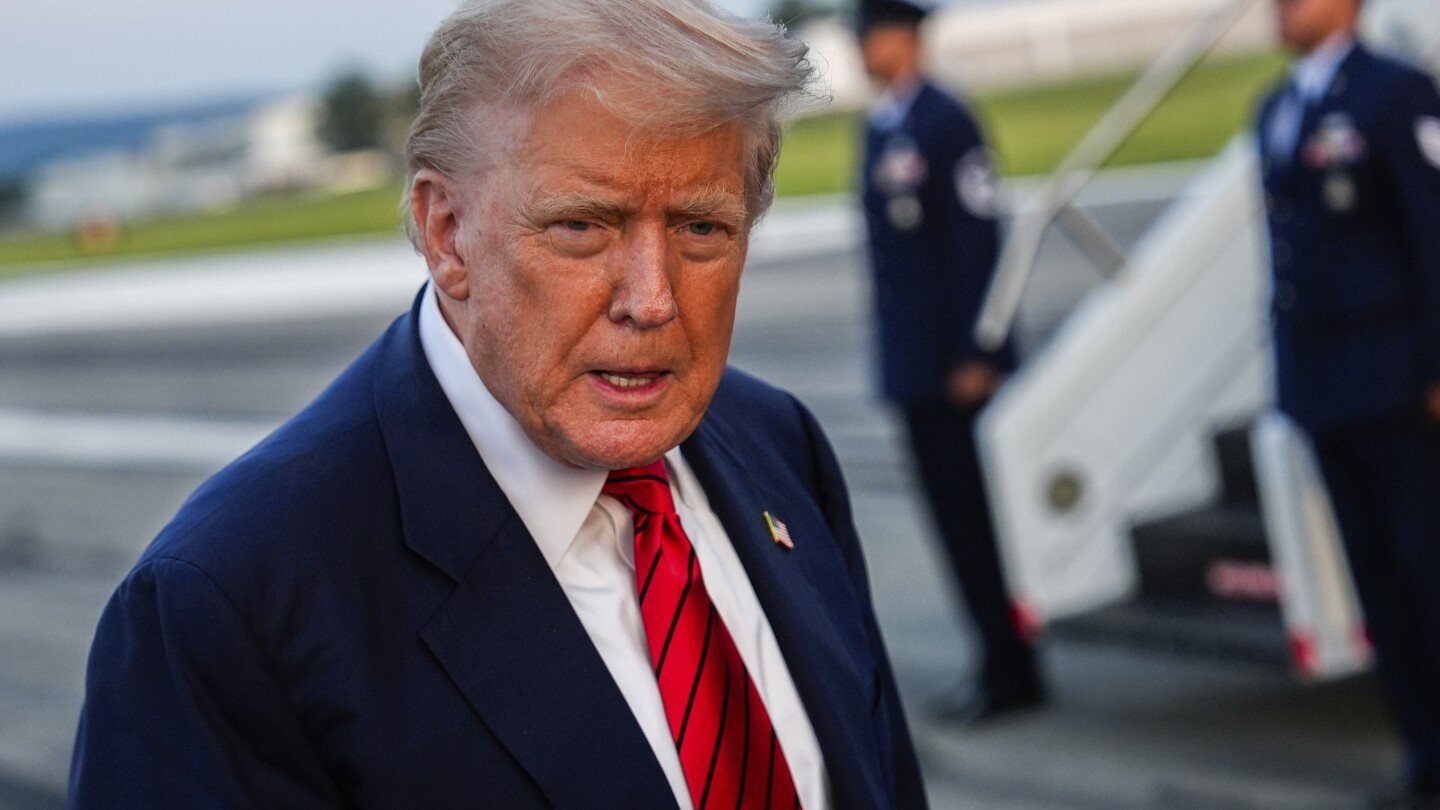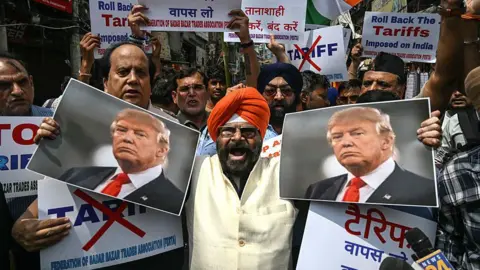Top Stories
Trump opens the door for private equity and crypto as 401k options

NEW YORK (AP) — Millions of Americans saving for retirement through 401(k) accounts could have the option of putting their money in higher-risk private equity and cryptocurrency investments, according to an executive order signed Thursday by President Donald Trump that could give those financial players long-sought access to a pool of funds worth trillions.
There is no immediate change in how people invest part of their work earnings. Federal agencies would need to rewrite rules and regulations to allow the expanded choices, and that would take months or more to complete. But once done, employers could offer a broader array of mutual funds and investments to workers, according to the White House. New plans could invest in alternative assets, particularly private equity, cryptocurrencies and real estate.
The Republican president’s order directs the Labor Department and other agencies to redefine what would be considered a qualified asset under 401(k) retirement rules.
Americans’ retirement plans are governed by a law known as the Employee Retirement Income Security Act of 1974, better known as ERISA. Employers are required by law to offer retirement options that are in the best interest of their employees, not Wall Street. Most retirement plans for Americans are made up of stock and bond investments, and to a much lesser extent, cash and heavily traded commodities such as gold.
Trump’s move rewards both the $5 trillion private equity industry, which for decades has wanted to compete for a role in retirement plans, and the cryptocurrency industry, whose executives strongly supported Trump’s 2024 campaign as they aimed for more mainstream acceptance among Americans.
The price of bitcoin was up 2% on Thursday to $116,542 and has nearly doubled since Trump was elected.
Under Democratic President Joe Biden, federal regulators were to treat cryptocurrency investments with “extreme care” because of the extreme volatility of crypto. It is not uncommon for bitcoin, ethereum and other big cryptocurrencies to move up or down 10% in a single day, whereas a 2% or 3% single-day move in the stock market would be considered historic.
For cryptocurrency companies, which donated millions to Trump’s campaign as well as his inauguration, one goal was to get their industry qualified under ERISA. Coinbase, one of the largest crypto companies in the United States, was also a major donor toward Trump’s military parade in Washington this summer. Under Trump, the Securities and Exchange Commission dropped its lawsuit against Coinbase, where the Biden administration said crypto should be treated as a security.
Crypto is particularly popular among young Americans. While volatile, bitcoin has generally moved upward since it was created by an anonymous programmer nearly 20 years ago.
“It was inevitable that bitcoin would make its way into American 401(k)’s,” said Cory Klippsten, the CEO of Swan Bitcoin. “As fiduciaries realize bitcoin’s risk-adjusted upside over the long term, we’ll see growing allocations, especially from younger, tech-savvy workers who want hard money, not melting ice cubes.”
Private equity firms rely heavily on high-net-worth individuals and state and private pension plans, which have extremely long investment timelines. But having access to Americans’ retirement assets would open up a deep pool of cash.
Blackstone CEO Steve Schwarzman has told investors going back to at least 2017 that it was a “dream” of his and the industry to be able to draw upon these retirement assets. Previous administrations, Republican and Democrat, have agreed that private equity investments, which can be riskier, more expensive and less liquid than traditional stock and bond market mutual funds, should not be included in 401(k) plans.
The average historic annual return on private equity assets going back to 1990 is roughly 13%, net of fees, according to Cambridge Associates. The S&P 500 index has had an approximate annual return, including dividends, of roughly 10.6% in the same period of time. However, private equity assets tend to be locked up for years, because the companies underlying the assets have to be sold on the private market, making them highly illiquid compared to stocks, which can be sold in a day.
“We look forward to working with the Trump Administration on a thoughtful framework that expands access to alternatives for retirement savers, offering Americans more diversification and investment options with appropriate investor guardrails,” said Bryan Corbett, the president and CEO of the Managed Funds Association, which is the trade group for the private equity industry.
Even after the regulations are written, it will take time for major retirement plan companies, such as Fidelity, Vanguard, T. Rowe Price, and others, to develop appropriate funds for employers to use. Employers are unlikely to revise their retirement plan options quickly, so it may take several years before crypto and private equity investments become mainstream in an individual’s retirement plan.
“While Vanguard has not committed to launching a product for defined contribution plans, Vanguard is dedicated to educating retirement investors to ensure a clear understanding of the opportunities and risks of investing in private assets,” the company said in a statement.
___
Top Stories
Craig Jones puts Chael Sonnen to sleep twice in CJI 2 superfight

Chael Sonnen stepped in as a late replacement for Gable Steveson at Sunday night’s Craig Jones Invitational 2 in Las Vegas and did his best to survive against Craig Jones.
In a match scheduled for three five-minute rounds, Sonnen managed to get tapped twice with the same move.
A former UFC middleweight and light heavyweight title challenger, Sonnen immediately took Jones to the ground to find himself locked in a buggy choke. The choke was tight, and Sonnen apparently went to sleep.
Sonnen regained his senses, and both athletes agreed to go at it again. Sonnen took Jones down again, going for a leg lock with no real danger to a grappler of Jones’ caliber. The CJI founder against attacked with the buggy choke, again having Sonnen go lights out.
McCarthy couldn’t help but laugh as Sonnen tried to make it best three out of five — and the crowd chanted to get the two go at it again —, but the referee called the end of the contest.
The official result was read as Jones being victorious via double buggy choke.
Watch the second finish below.
Top Stories
Liverpool agrees to British-record deal for Alexander Isak, sources say

Liverpool have agreed to a British-record deal to sign striker Alexander Isak from Newcastle United, sources told ESPN.
The Premier League champions have had a £125M bid accepted to sign the Sweden international, who is expected to undergo a medical ahead of Monday’s transfer deadline.
It brings an end to one of the summer’s most-protracted transfer sagas, with Isak having spent more than a month agitating for a move away from Newcastle. The 25-year-old did not join the club on their preseason tour of the Far East and has not featured for Eddie Howe’s side this season.
He also released a sensational statement earlier this month in which he claimed promises had been “broken” by the Newcastle hierarchy and insisted a move this summer would be in the best interests of all parties.
Isak is now set to become the most expensive signing in Premier League history, surpassing Chelsea’s Moisés Caicedo who joined the London club for £115M from Brighton & Hove Albion in the summer of 2023. It marks the second time this summer that Liverpool have broken their transfer record, with Arne Slot’s side having committed spending an initial £100M (plus a potential £16M in add-ons) to sign Florian Wirtz from Bayer Leverkusen in June.
Top Stories
Donald Trump as the wildcard and other takeaways for India-China relationship

Vikas PandeyIndia editor and
Stephen McdonellChina correspondent
 Reuters
ReutersThe view from India
Just a few months ago, the armed forces of India and Pakistan were locked in a brief but deadly conflict.
The conflict indirectly involved a third nation – China. Pakistan’s armed forces heavily used China-made equipment, including fighter jets and radar systems.
A senior army officer in Delhi said Beijing also provided “live inputs” to Pakistan on Indian positions.
India didn’t take a public stand against China, but this left many asking if Delhi should continue on the path of normalising relations with Beijing.
Less than six months later, peace talks between the two Asian giants have been turbocharged by decisions taken thousands of miles away in Washington DC.
The Trump administration has imposed 50% tariffs on Indian imports, saying Delhi was being punished for its refusal to stop buying oil from Russia.
Delhi had two clear choices after this stunning onslaught from a trusted ally.
The first was to cave in and stop buying Russian oil. But it has refused to do so, largely because Russia is an “all-weather” ally and giving into pressure doesn’t suit Indian Prime Minister Narendra Modi’s strongman image.
The second was to stand firm and seek other opportunities and India appears to have to chosen this option for now.
It’s also pragmatic to look no further when your neighbour is the world’s second-largest economy and a global manufacturing powerhouse.
It was in this context, that Modi met Chinese President Xi Jinping in Tianjin over the weekend.
Statements from the two sides were not heavy on details, though they promised to work through their differences to benefit their collective population of 2.8 billion people.
The immediate takeaway from the meeting was the resumption of direct flights between the two countries and making the process of issuing visas simpler.
But beyond the promise of “the elephant and the dragon” coming together, the two countries still have major roadblocks to clear before they are able to engage meaningfully.
Their first challenge comes from their immediate history.
Modi has invested personally in the India-China relationship since coming to power in 2014, visiting the neighbouring country five times until 2018.
But the 2020 border clash put brakes on this momentum and it has taken seven long years for Modi to visit China again.
The key to making further progress will depend on how the two countries deal with their border issues.
Tens of thousands of troops from both countries are still deployed at their contested borders – though there are ongoing talks between their civilian and military leaders to ease the situation.
 AFP via Getty Images
AFP via Getty ImagesBoth Chinese and Indian readouts after the meeting this weekend talked about maintaining peace at the border and “not turning their differences into disputes”.
For India, there is the issue of a burgeoning trade deficit with China, amounting to more than $99bn (£73bn).
Both countries still have high tariffs and duties against each other in many sectors.
Beijing would want India to open its market of 1.4 billion people to Chinese products, but Delhi would be wary of doing that without addressing the deficit.
The outreach to China, which started with Modi meeting Xi in Kazan last year, may have been supercharged by Trump tariffs, but ground realities for India remain unchanged.
The Modi-Xi meeting is being seen as part of India’s policy of “strategic autonomy” but it will also cause more geopolitical challenges for Delhi.
India is due to host the Quad (which includes Japan, Australia and the US) summit later this year. The forum was largely seen as a challenge to China’s dominance in the Indo-Pacific region.
It’s not clear if Trump will attend, but if he does and says something against China, it will immediately test the renewed synergy between Delhi and Beijing.
Delhi is also part of several other multilateral forums that are perceived as anti-China and anti-Russia.
How Delhi plays its strategic autonomy in the next few months will very much influence the direction India-China ties take.
For now, it’s clear that India-US ties are at an all-time low. A Trump aide recently called the Russia-Ukraine conflict “Modi’s war”.
Delhi has also consistently denied that Trump played any role in the ceasefire between India and Pakistan in May – this has become a constant irritant for the US president.
Despite this, India has refrained from imposing retaliatory tariffs against the US and has left the door ajar for further negotiations. After all, the US is India’s biggest trading partner.
Will going closer to China help India’s negotiations with the US or will it have the opposite impact?
This is the question that will likely dominate geopolitical discussions in Delhi and beyond in the coming months.
 Hindustan Times via Getty Images
Hindustan Times via Getty ImagesThe view from China
When Xi Jinping met Narendra Modi he used what has become his favourite catchphrase for China-India relations: “The dragon and the elephant should come together”.
During “this period of transformation,” he added that it was vital for the world’s most populous nations to be friends and good neighbours.
In a case of spectacular timing, Prime Minister Modi’s visit has coincided with Donald Trump’s tariffs of up to 50% on India exports to the US.
This represents quite a hit on the country’s economy so New Delhi would be looking around for other business partners.
Look no further than right here, Xi may well say, as his administration attempts to rebuild from the wreckage of China-India relations following years of tension between the two.
And, if their official readouts are anything to go by, Modi’s attendance at the Tianjin Summit of the Shanghai Cooperation Organisation seems to have paid off.
His published comments to Xi were much more specific than the those coming the other way.
There is now a very good window for Beijing and New Delhi to repair their strained relationship.
China’s leader knows that Donald Trump’s tariff onslaught is pushing India away from the United States and that this great economic rival needs other partnerships.
Considerable obstacles remain.
They include China’s backing of India’s key rival Pakistan; interaction of all types has been in the doldrums; angry rhetoric from both governments (over many years) has created a climate of suspicion between the Asian heavyweights and their high-mountain border dispute has stirred nationalist sentiment on both sides of the frontier.
However, with the latter of these, this meeting would appear to confirm that pressure has already eased.
Last Thursday China’s Defence Ministry spokesman was talking up the success of discussions between the representatives of China and India aimed at stopping the clashes along their disputed border.
He spoke of “win-win cooperation” and celebrating the 75th anniversary of ties between the two nations.
Xi also knows that the symbolism of having Modi in China right now is considerable, that images of them shaking hands and standing side-by-by side – as the Trump tariffs on India kick in – can be a powerful propaganda tool which is made even more significant by the fact that this is a multilateral gathering.
The two will not only be joined by Vladimir Putin but by the other SCO governments like Turkey (a member of Nato), Saudi Arabia (a key US ally), Iran (a key enemy of the US) as well as Qatar, Egypt and Pakistan.
And all of this in the days before Beijing holds a massive display of military might with a parade through the heart of the capital.
-
Tools & Platforms3 weeks ago
Building Trust in Military AI Starts with Opening the Black Box – War on the Rocks
-

 Business3 days ago
Business3 days agoThe Guardian view on Trump and the Fed: independence is no substitute for accountability | Editorial
-

 Ethics & Policy1 month ago
Ethics & Policy1 month agoSDAIA Supports Saudi Arabia’s Leadership in Shaping Global AI Ethics, Policy, and Research – وكالة الأنباء السعودية
-

 Events & Conferences3 months ago
Events & Conferences3 months agoJourney to 1000 models: Scaling Instagram’s recommendation system
-

 Jobs & Careers2 months ago
Jobs & Careers2 months agoMumbai-based Perplexity Alternative Has 60k+ Users Without Funding
-

 Funding & Business2 months ago
Funding & Business2 months agoKayak and Expedia race to build AI travel agents that turn social posts into itineraries
-

 Education2 months ago
Education2 months agoVEX Robotics launches AI-powered classroom robotics system
-

 Podcasts & Talks2 months ago
Podcasts & Talks2 months agoHappy 4th of July! 🎆 Made with Veo 3 in Gemini
-

 Podcasts & Talks2 months ago
Podcasts & Talks2 months agoOpenAI 🤝 @teamganassi
-

 Mergers & Acquisitions2 months ago
Mergers & Acquisitions2 months agoDonald Trump suggests US government review subsidies to Elon Musk’s companies




















